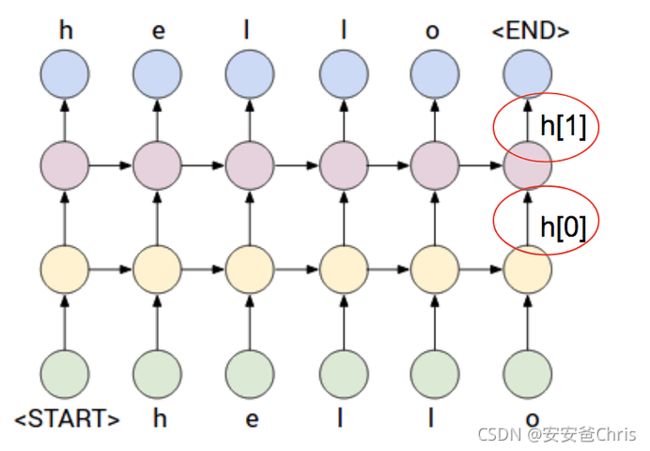【pytorch】nn.LSTM的使用
官方文档在这里。
LSTM具体不做介绍了,本篇只做pytorch的API使用介绍
torch.nn.LSTM(*args, **kwargs)
输入张量
输入参数为两个,一个为input Tensor,一个为隐藏特征和状态组成的tuple
Inputs: input, (h_0, c_0)
input只能为3维张量,其中当初始参数batch_first=True时,shape为(L,N,H);而当初始参数batch_first=False时,shape为(N,L,H);
公式
LSTM中weights
以下公式介绍都忽略bias
- 公式(1), 输入门
i t = δ ( W i i x t + W h i h t − 1 ) i_t = \delta(W_{ii}x_t+W_{hi}h_{t-1}) it=δ(Wiixt+Whiht−1), LSTM中有关输入的参是是 W i i W_{ii} Wii和 W h i W_{hi} Whi - 公式(2),遗忘门
f t = δ ( W i f x t + W h f h t − 1 ) f_t = \delta(W_{if}x_t+W_{hf}h_{t-1}) ft=δ(Wifxt+Whfht−1), LSTM中有关输入的参数是 W i f W_{if} Wif和 W h f W_{hf} Whf - 公式(3),细胞更新状态
g t = δ ( W i g x t + W h g h t − 1 ) g_t = \delta(W_{ig}x_t+W_{hg}h_{t-1}) gt=δ(Wigxt+Whght−1), LSTM中有关输入的参数是 W i g W_{ig} Wig和 W h g W_{hg} Whg - 公式(4),输出门
o t = δ ( W i o x t + W h o h t − 1 ) o_t = \delta(W_{io}x_t+W_{ho}h_{t-1}) ot=δ(Wioxt+Whoht−1), LSTM中有关输入的参数是 W i o W_{io} Wio和 W h o W_{ho} Who
所以从输入张量和隐藏层张量来说,一共有两组参数
- input 组 { W i i W_{ii} Wii, W i f W_{if} Wif, W i g W_{ig} Wig, W i o W_{io} Wio }
- hidden组 { W h i W_{hi} Whi, W h f W_{hf} Whf, W h g W_{hg} Whg, W h o W_{ho} Who }
这里就对应官网上的两个参数

因为hidden size为隐藏层特征输出长度,所以每个参数第一维度都是hidden size;然后每一组是把4个张量按照第一维度拼接,所以要乘以4
举例代码:
from torch import nn
lstm = nn.LSTM(input_size=3, hidden_size=6, num_layers=1, bias=False)
print('weight_ih_l0.shape = ', lstm.weight_ih_l0.shape, ', weight_hh_l0.shape = ' , lstm.weight_hh_l0.shape)
双向LSTM
如果要实现双向的LSTM,只需要增加参数bidirectional=True
双向的区别是LTSM参数中 hidden 参数会增加一个方向,即有来有回,所以要double以下。
举例代码
from torch import nn
lstm = nn.LSTM(input_size=3, hidden_size=6, num_layers=2, bias=False, bidirectional=True)
print('weight_ih_l0.shape = ', lstm.weight_ih_l0.shape, ', weight_ih_l0_reverse.shape = ', lstm.weight_ih_l0_reverse.shape,
'\nweight_hh_l0.shape = ' , lstm.weight_hh_l0.shape, ', weight_hh_l0_reverse.shape = ', lstm.weight_hh_l0_reverse.shape)
主要是hh部分的最后一维增加了一倍。
多层的概念
LSTM中有个参数num_layers是设置层数的,如果num_layers大于1,则网络则会变成如下的拓展
有关讨论请参考这里。
每多一层,就多一组**LSTM.weight_ih_l[k]和LSTM.weight_hh_l[k]**参数
两层的网络里有 LSTM.weight_ih_l0、LSTM.weight_ih_l0和LSTM.weight_ih_l1和LSTM.weight_hh_l1
LSTM的计算示例代码
input_size 为3,hidden_size 为4,
# shape [Sequence Length, Batch Size, Feature Size]
# 如果batch_first=True,则为 [Batch Size, Sequence Length, Feature Size]
x=torch.Tensor([0,0,1,1,1,1,0,0,0,0,0,0]).view(2,3,2)
print(x,x.shape)
# h0 c0 的三维度分别为 [Layer Size, Batch Size, Hidden Feature Size]
h0=torch.zeros(1,3,4)
c0=torch.zeros(1,3,4)
# 默认batch_first=False,所以输入张量的第1维度是Batch
net=nn.LSTM(2, 4, bias=False)
print("net.weight_ih_l0=", net.weight_ih_l0, net.weight_ih_l0.shape)
print("net.weight_hh_l0=", net.weight_hh_l0, net.weight_hh_l0.shape)
y,_=net(x, (h0,c0))
print(y, y.shape)
tensor([[[0., 0.],
[1., 1.],
[1., 1.]],
[[0., 0.],
[0., 0.],
[0., 0.]]]) torch.Size([2, 3, 2])
net.weight_ih_l0= Parameter containing:
tensor([[-0.1310, 0.0330],
[-0.3115, -0.0417],
[-0.1452, 0.0426],
[-0.0096, 0.3305],
[-0.1104, 0.1816],
[ 0.1668, -0.3706],
[ 0.4792, -0.3867],
[-0.4565, 0.0688],
[ 0.0975, -0.0737],
[ 0.2898, 0.2739],
[-0.3564, 0.2723],
[-0.1759, 0.2534],
[ 0.3471, -0.1051],
[ 0.4057, 0.3256],
[ 0.4224, 0.4646],
[-0.0107, -0.2000]], requires_grad=True) torch.Size([16, 2])
net.weight_hh_l0= Parameter containing:
tensor([[ 0.4431, 0.4195, -0.4328, 0.0183],
[ 0.4375, 0.0306, -0.0641, -0.2027],
[-0.3726, -0.0434, -0.4403, 0.2741],
[-0.2962, -0.2381, -0.4713, -0.1349],
[-0.1447, -0.0184, 0.3634, -0.0840],
[-0.4828, -0.2628, 0.4112, -0.0554],
[ 0.2004, -0.4253, -0.1785, 0.4688],
[ 0.2922, -0.1926, -0.2644, 0.2561],
[ 0.4504, -0.3577, -0.2971, -0.2796],
[ 0.0442, -0.0018, -0.3970, 0.3194],
[ 0.2986, -0.2493, -0.4371, 0.2953],
[-0.0342, -0.2422, -0.2986, 0.0775],
[ 0.4996, 0.1421, -0.1665, 0.1231],
[-0.3341, -0.0462, -0.1578, -0.1443],
[-0.0194, 0.3979, 0.0734, -0.2276],
[ 0.0581, -0.3744, 0.4785, -0.0365]], requires_grad=True) torch.Size([16, 4])
tensor([[[ 0.0000, 0.0000, 0.0000, 0.0000],
[ 0.0064, 0.1402, -0.0282, 0.0200],
[ 0.0064, 0.1402, -0.0282, 0.0200]],
[[ 0.0000, 0.0000, 0.0000, 0.0000],
[-0.0089, 0.0553, -0.0138, 0.0050],
[-0.0089, 0.0553, -0.0138, 0.0050]]], grad_fn=) torch.Size([2, 3, 4])
相关参考: Understanding LSTM and its diagram


